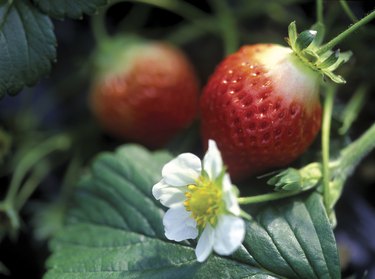
Cultivars of the common garden strawberry (Fragaria x ananassa) are perennials in U.S. Department of Agriculture plant hardiness zones 3 through 10, but they may require protection from excessive winter cold or unexpected freezes in spring. Hot spring weather can affect their yield, and they grow best in cool summers.
Temperatures for Strawberry Yields
Video of the Day
Strawberries that are June-bearers produce one large crop of fruit from late June through early July. They grow fruits on above-ground runners. Their berries ripen about 30 days after planting when the air temperatures are 70 to 80 degrees Fahrenheit during the day and 60 to 65 F at night. Springtime temperatures above 80 F reduce their yield. Cool the plants with overhead sprinkling when the temperature is above 85 F, and stop sprinkling when the temperature drops below that number.
Video of the Day
Everbearing strawberries produce two crops each year, one in June and a second, smaller crop in early autumn. They typically need nighttime temperatures below 65 F to yield berries.
Day-neutral strawberries yield a small amount berries from late spring to early autumn when temperatures are between 35 and 85 F.
Plant strawberries in spring as soon as the soil is warm enough to work. If you plant them in late spring, their roots may not have time to develop before hot, dry weather arrives.
Cold Limits
When strawberry plants are dormant or while their buds are not yet growing, the buds can survive temperatures as low as 10 F.
When the buds are growing but the flowers are not open, the buds can survive temperatures from 22 to 27 F.
As their flowers open, strawberry plants can survive temperatures of 32 F, but their small, green fruits withstand temperatures only as low as 28 F.
Spring Cold Protection
Protect strawberry plants when freezing weather hits in spring by beginning to sprinkle them just before their temperature drops to 32 F. Ice will form on the plants; if you keep the ice wet, the plants' temperature will stay at 32 F. The task requires applying 1/10 to 1/15 inch of water per hour with the sprinklers rotating once each minute. Stop sprinkling when the temperature rises and the ice melts.
If freezing temperatures -- 32 F and lower -- are forecast for a night while strawberries are blooming, then place a sheet of light canvas or polyethylene over the plants in early evening, and remove it the next morning when the risk of frost has passed.
Winter Protection
Persistent winter freezing and thawing can lift strawberry plants out of the ground, and winter temperatures below 22 F can damage their crowns and buds. A crown is place where a plant's roots and upper portion meet.
Persistent snow can help protect plants during winter. Mulch helps, too. Apply a roughly 2-inch-thick layer of organic mulch over strawberry plants when the soil freezes in autumn. Evergreen boughs, paper, leaves, clean straw -- especially barley straw -- and sawdust are effective mulches.
Remove the mulch from the plants when their new leaves appear in spring. Leave the mulch between plant rows and around -- but not touching -- the plants, however, to suppress weeds and conserve water.
- University of Delaware Cooperative Extension: Critical Temperatures for Strawberry Buds and Blossoms and Freeze Protection
- Master Gardeners of Santa Clara County, California: Growing Strawberries for the Home Garden
- Purdue University Cooperative Extension Service: Growing Strawberries
- Oregon State University Extension Service: Growing Strawberries in Your Home Garden
- Maine Organic Farmers and Gardeners Association: Organic Strawberry Production
- The Old Farmer's Almanac: Strawberries
- Montana State University Extension: Strawberries in the Home Garden
- University of Delaware Cooperative Extension: High Temperatures Can Affect Strawberry Yields
- Cornell University: Cornell Guide to Growing Fruit at Home -- Strawberries
- Mother Earth News: All About Growing Strawberries